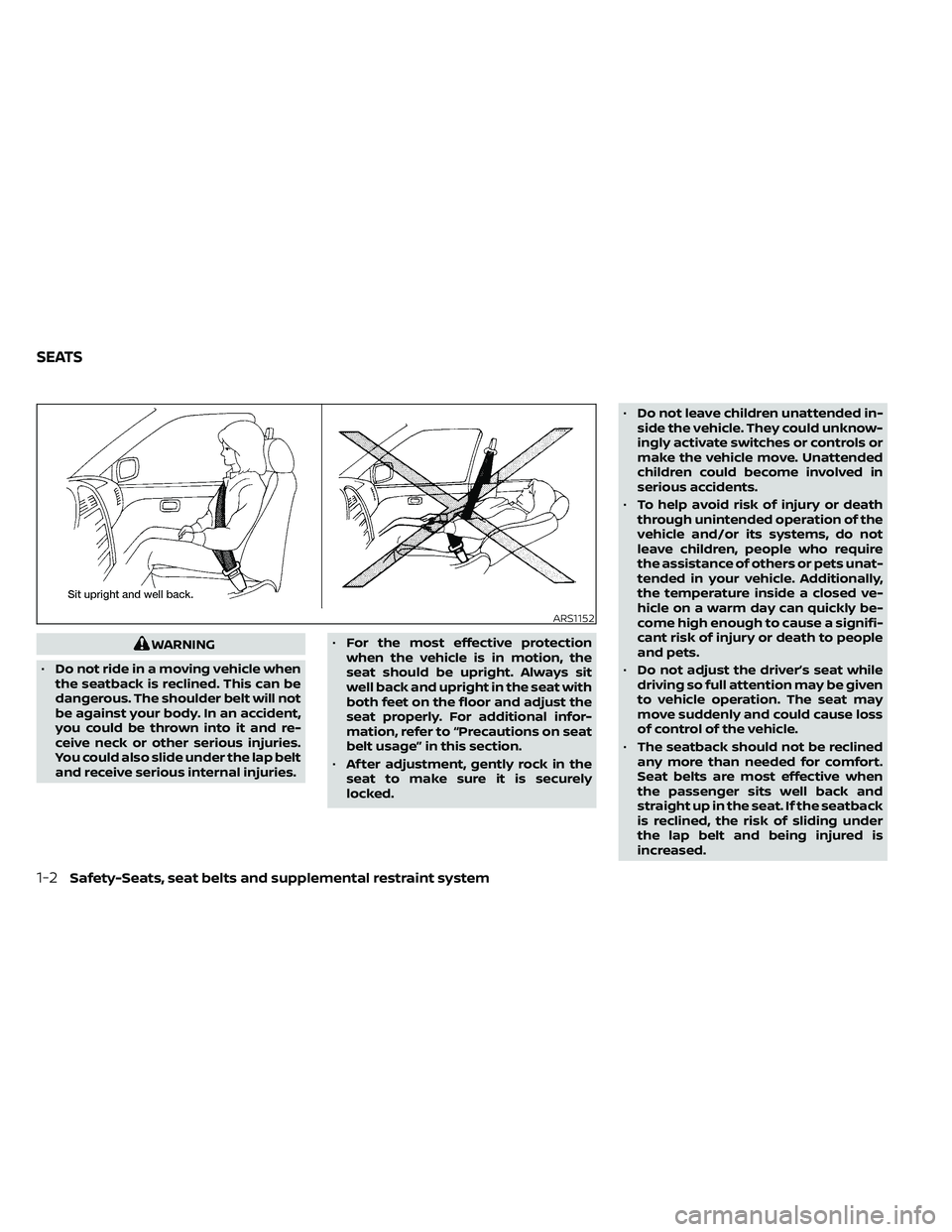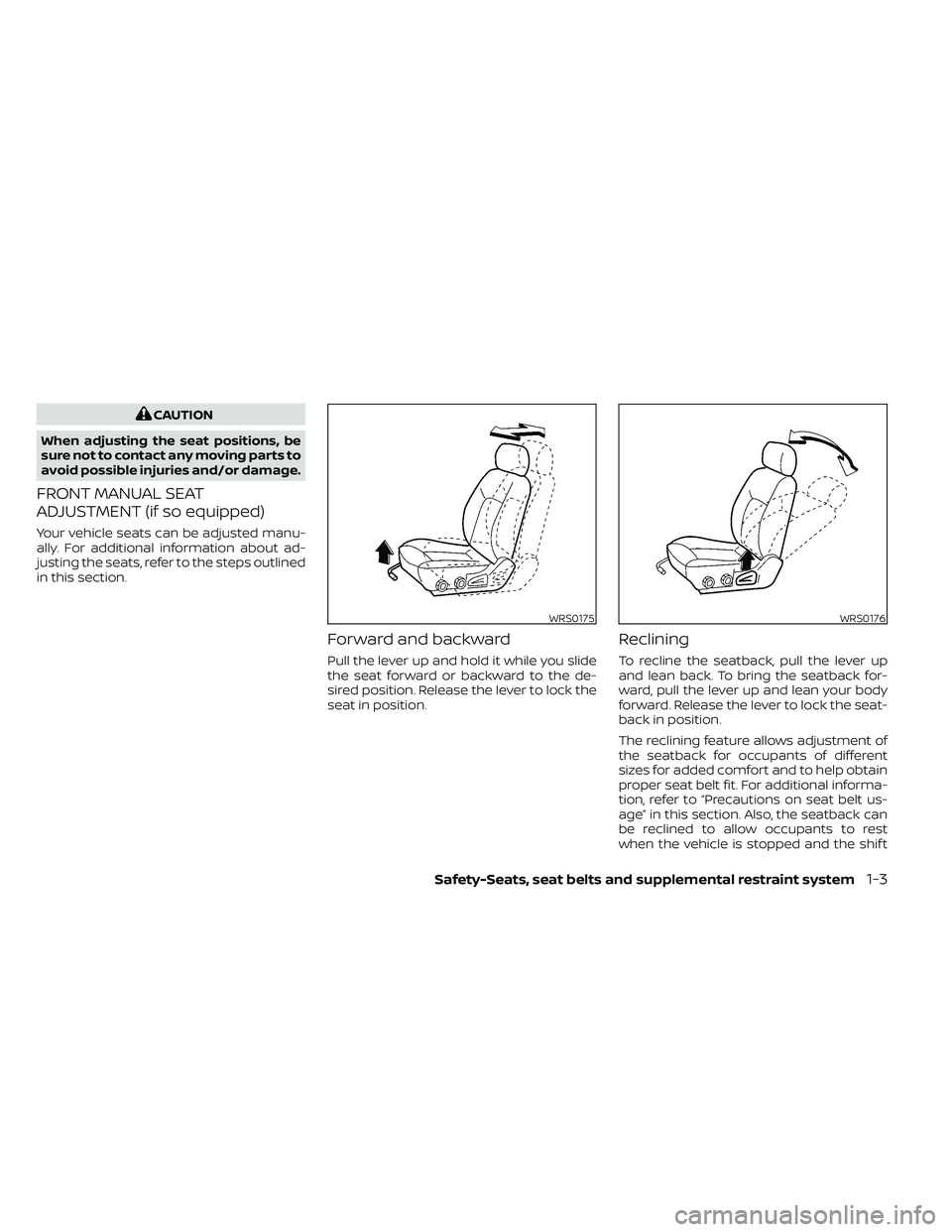Page 9 of 492
Table of
contents
Safety-Seats, seat belts and supplemental restraint system
Instruments and controls
Pre-driving checks and adjustments
Monitor, climate, audio, phone and voice recognition systems
Starting and driving
In case of emergency
Appearance and care
Do-it-yourself
Maintenance and schedules
Technical and consumer information
Index
0
1
2
3
4
5
6
7
8
9
10
11
Page 12 of 492
1. Rear seat belts (P. 1-15)
2. Roof-mounted curtain side-impact androllover supplemental air bag (P. 1-70)
3. Head restraints/headrests (P. 1-10)
4. Front seat belts with pretensioner(s)
and shoulder height adjuster
(P. 1-15, 1-70)
5. Supplemental front-impact air bags
(P. 1-70)
6. Seats (P. 1-2)
7. Occupant classification sensor
(pressure sensor) (P. 1-70)
8. Front seat-mounted side-impact
supplemental air bag (P. 1-70)
9. LATCH (Lower Anchors and Tethers for
CHildren) system (P. 1-28)
10. Top tether strap anchor (P. 1-28)
Refer to the page number indicated in
parentheses for operating details.
Page 18 of 492
VQ38DD engine
1. Windshield-washer fluid reservoir(P. 8-12)
2. Fuse/Fusible link box (P. 8-20)
3. Fuse/Fusible link box (P. 8-20)
4. Fuse box (P. 8-20)
5. Engine oil filler cap (P. 8-6)
6. Engine oil dipstick (P. 8-6)
7. Brake fluid reservoir (P. 8-11)
8. Air cleaner (P. 8-17)
9. Drive belt location (P. 8-15)
10. Power steering fluid reservoir (P. 8-10)
11. Radiator cap (P. 8-4)
12. Battery (P. 8-13)
13. Engine coolant reservoir (P. 8-4)
*Engine cover removed for clarity.
Refer to the page number indicated in
parentheses for operating details.
Page 19 of 492
WarninglightName Page
model) 2-15
or
Anti-lock Braking
System (ABS)warning light 2-15
or
Apply parking brake
warning light 2-16
Automatic transmis-
sion check warning light 2-16
model)2-16
or
Brake warning light 2-16
Charge warning light 2-17
Door open warning
light 2-17
Electric shif t control
system warning light 2-17
Low fuel warning
light 2-18
Low tire pressure
warning light 2-18
Low windshield-
washer fluid warning light (if so equipped) 2-19
NISSAN Intelligent
Key® warning light (if so equipped) 2-20
Seat belt warning
light and chime 2-20
WARNING AND INDICATOR LIGHTS
Illustrated table of contents0-9
Page 22 of 492

1 Safety-Seats, seat belts and
supplemental restraint system
Seats............................................ 1-2Front manual seat adjustment
(if so equipped) ................................1-3
Front power seat adjustment
(if so equipped) ............................... 1-5
Rear bench seat (if so equipped) ............. 1-6
Jump seat (if so equipped) ....................1-7
Armrest (if so equipped) .......................1-7
Flexible seating ................................1-7
Head restraints/headrests ......................1-10
Adjustable head restraint/headrest
components ................................. 1-11
Non-adjustable head restraint/headrest
components................................. 1-12
Remove...................................... 1-12
Install ........................................ 1-13
Adjust ........................................ 1-13
Front-seat active head restraints .............1-14
Seatbelts ....................................... 1-15
Precautions on seat belt usage ...............1-15
Seat belt warning light and chime ............1-18
Pregnant women ............................ 1-18
Injured persons .............................. 1-18Three-point type seat belt with
retractor .....................................
1-19
Seat belt extenders ......................... 1-24
Seat belt maintenance ......................1-24
Child safety .................................... 1-25
Infants ...................................... 1-26
Small children ............................... 1-26
Larger children .............................. 1-26
Child restraints ................................. 1-28
Precautions on child restraints ..............1-28
LATCH (Lower Anchors and Tethers for
CHildren) system ............................ 1-30
Rear-facing child restraint installation
using LATCH (Crew Cab models) .............1-34
Rear-facing child restraint installation
using LATCH — jump seat
(King Cab® models) .......................... 1-36
Rear-facing child restraint installation
using the seat belts (Crew Cab models) .....1-39
Rear-facing child restraint installation
using the seat belts — jump seat
(King Cab® models) .......................... 1-42
Page 24 of 492

WARNING
• Do not ride in a moving vehicle when
the seatback is reclined. This can be
dangerous. The shoulder belt will not
be against your body. In an accident,
you could be thrown into it and re-
ceive neck or other serious injuries.
You could also slide under the lap belt
and receive serious internal injuries. •
For the most effective protection
when the vehicle is in motion, the
seat should be upright. Always sit
well back and upright in the seat with
both feet on the floor and adjust the
seat properly. For additional infor-
mation, refer to “Precautions on seat
belt usage” in this section.
• Af ter adjustment, gently rock in the
seat to make sure it is securely
locked. •
Do not leave children unattended in-
side the vehicle. They could unknow-
ingly activate switches or controls or
make the vehicle move. Unattended
children could become involved in
serious accidents.
• To help avoid risk of injury or death
through unintended operation of the
vehicle and/or its systems, do not
leave children, people who require
the assistance of others or pets unat-
tended in your vehicle. Additionally,
the temperature inside a closed ve-
hicle on a warm day can quickly be-
come high enough to cause a signifi-
cant risk of injury or death to people
and pets.
• Do not adjust the driver’s seat while
driving so full attention may be given
to vehicle operation. The seat may
move suddenly and could cause loss
of control of the vehicle.
• The seatback should not be reclined
any more than needed for comfort.
Seat belts are most effective when
the passenger sits well back and
straight up in the seat. If the seatback
is reclined, the risk of sliding under
the lap belt and being injured is
increased.
Page 25 of 492

CAUTION
When adjusting the seat positions, be
sure not to contact any moving parts to
avoid possible injuries and/or damage.
FRONT MANUAL SEAT
ADJUSTMENT (if so equipped)
Your vehicle seats can be adjusted manu-
ally. For additional information about ad-
justing the seats, refer to the steps outlined
in this section.
Forward and backward
Pull the lever up and hold it while you slide
the seat forward or backward to the de-
sired position. Release the lever to lock the
seat in position.
Reclining
To recline the seatback, pull the lever up
and lean back. To bring the seatback for-
ward, pull the lever up and lean your body
forward. Release the lever to lock the seat-
back in position.
The reclining feature allows adjustment of
the seatback for occupants of different
sizes for added comfort and to help obtain
proper seat belt fit. For additional informa-
tion, refer to “Precautions on seat belt us-
age” in this section. Also, the seatback can
be reclined to allow occupants to rest
when the vehicle is stopped and the shif t
WRS0175WRS0176
Page 26 of 492
lever is in P (Park) or N (Neutral) position
with the parking brake fully applied.
Seat lif ter (if so equipped for
driver's seat)
Turn either dial to adjust the angle and
height of the seat cushion to the desired
position.
Lumbar support (if so equipped
for driver's seat)
The lumbar support feature provides ad-
justable lower back support to the driver.
Move the lever forward or backward to ad-
just the seat lumbar area.
WRS0131WRS0389
1-4Safety-Seats, seat belts and supplemental restraint system